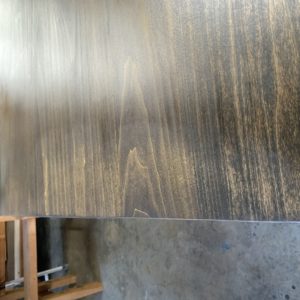Hey all,
I’m kind of new to woodworking and so I’m learning by reading and making mistakes. I’ve made a few projects with staining and I never ran into this problem until I went to stain my first ever table top. During the final stages of sanding I was round my corners over a little with 220 sand paper. However, this is also where I made my mistake. I know that we are supposed to sand with grain however when sanding the table ends I scuffed cross grain and then forgot to sand those out before staining. Well needless to say after staining I noticed the scratches right away. In an effort to remove the scratches I tried sanding down the scratches with 120 and then smoothing over with 220 like I did with the rest of the table. Only this time after staining the repair attempt, the stain is much lighter than the rest of the table. I only applied one coat to the table top. After it dried, I put on another layer where I made my repairs, thinking it might soak up a bit more to darken and get a closer match… but as you can see that didn’t happen.
anyway, can someone explain what happened here so that I understand how it happened and how I can fix mistakes like this with better results?
also, any tips on what I can do to make this look a little better before I seal it?
thanks all!
joe
















Replies
Ouch.
I suspect that most of what you see is actually just differences in the sanding scratch pattern and only you will ever see it.
You have two choices that make sense here:
1. Try finishing it. If you are planning something like a poly or shellac, this will fill the scratches and probably even the tone of the stain a lot. Chances are no-one will notice if you don't point it out.
2. Sand it way back and re-stain it as one - that way it will all end up the same.
I'd do the first one personally because you can always do the second if you don't put too thick a layer on first. Shellac wins for me as you can always put another finish over the top if the 'sanding sealer' layer sorts the issue out and it is minimal effort to sand away if it does not work. If you use wax then you'll have to live with what you get.
I'd also wait and see if more experienced woodworkers than me give an answer - I have done this once and finishing worked for me, but it was a much smaller project. Others may have better ideas.
It looks like the wood fibers at the repair have been burnished a bit and therefore don't take the stain like other parts of the table. You can try going back to 120 grit and working all the grits up to 220. Then refinish the repaired section. Use new sharp sandpaper for all of the grits but use 120, 150, 180 220 in succession.
This forum post is now archived. Commenting has been disabled